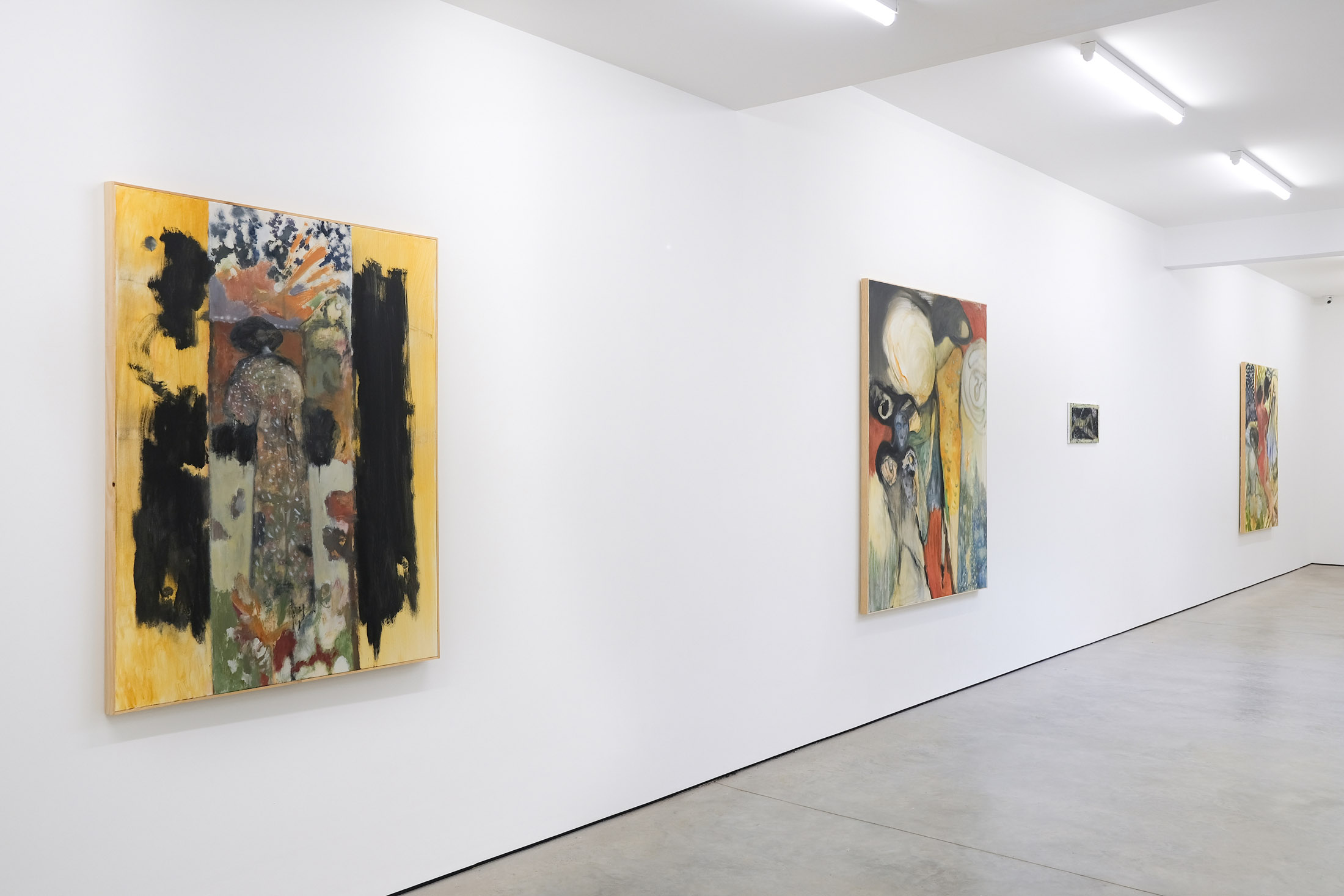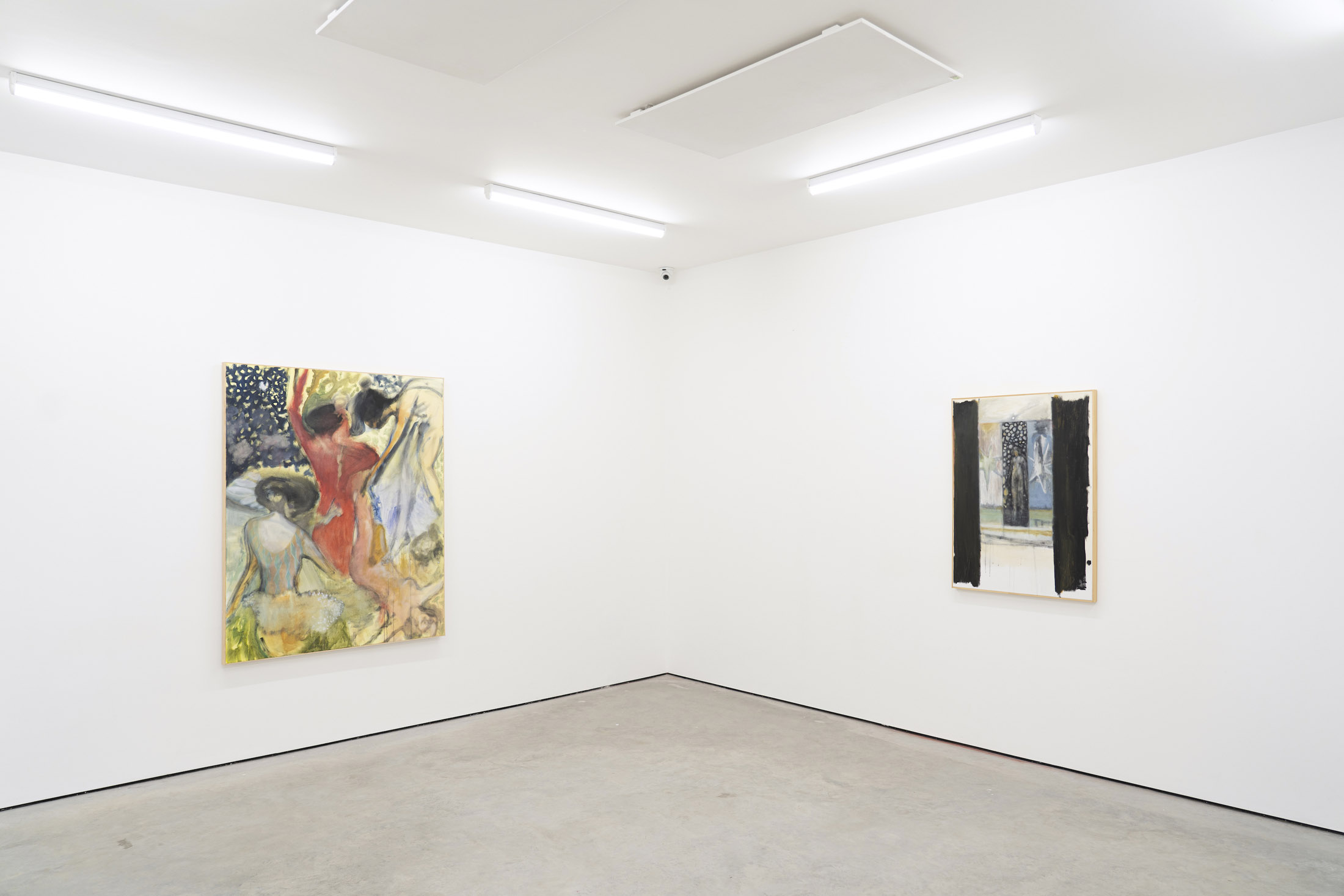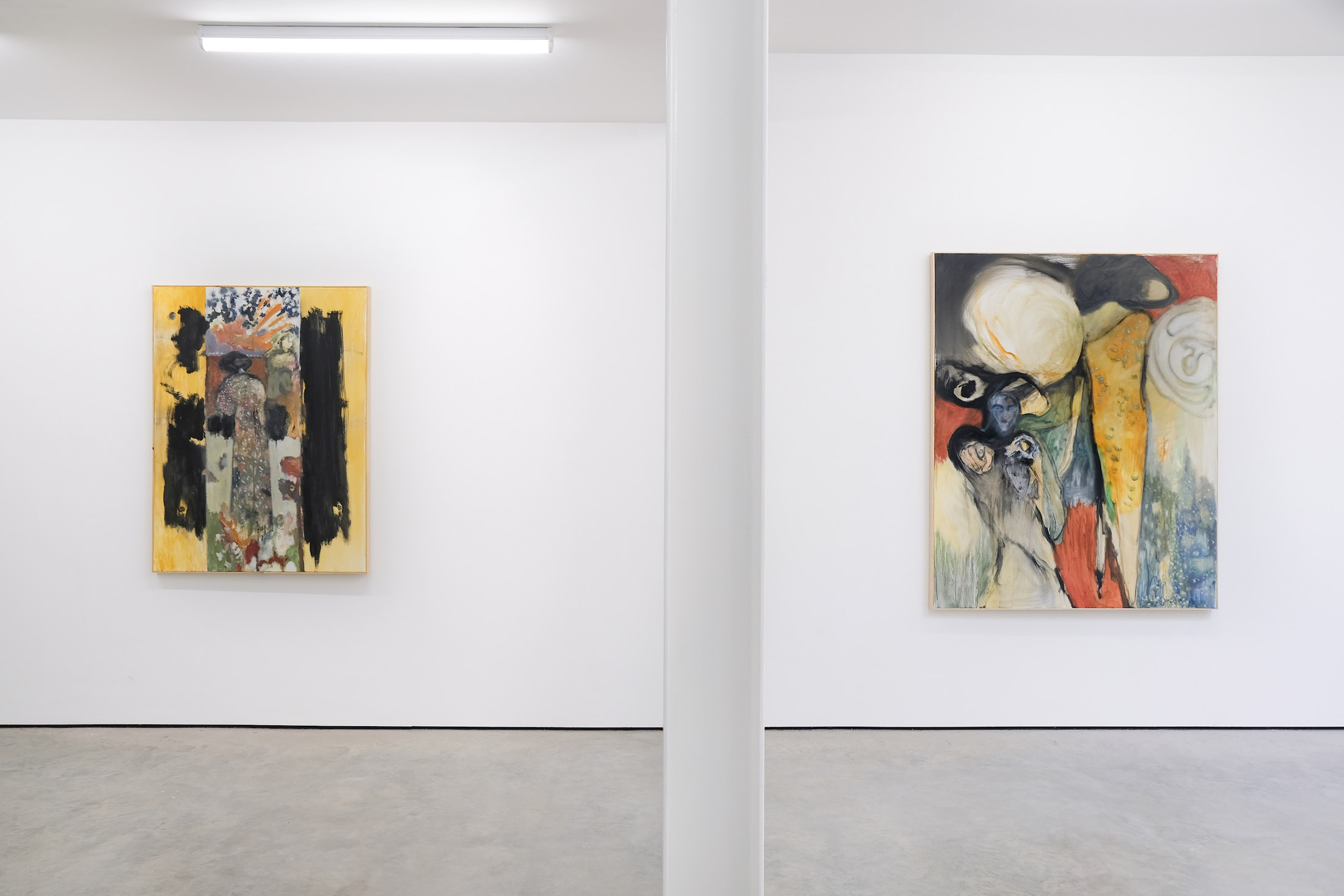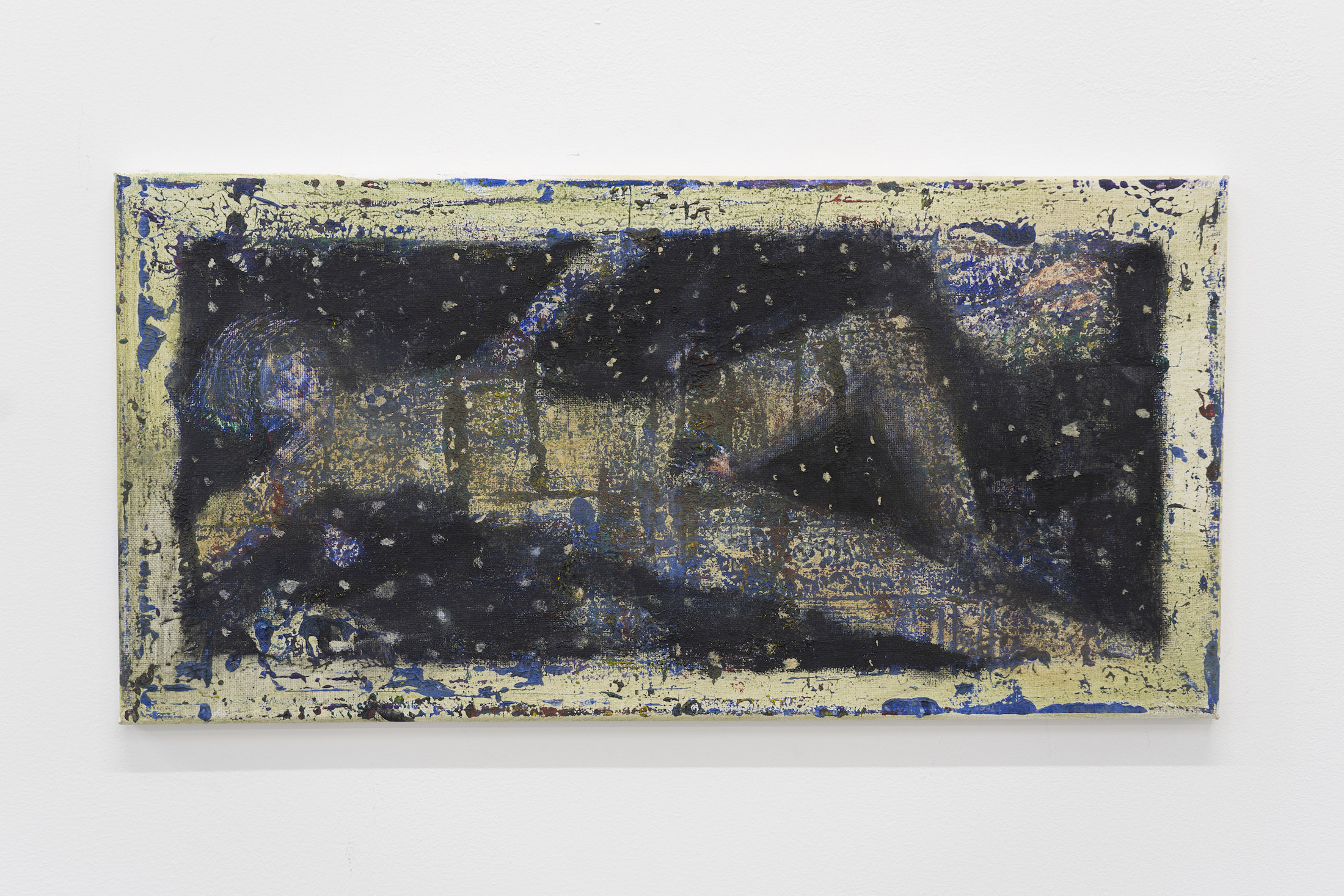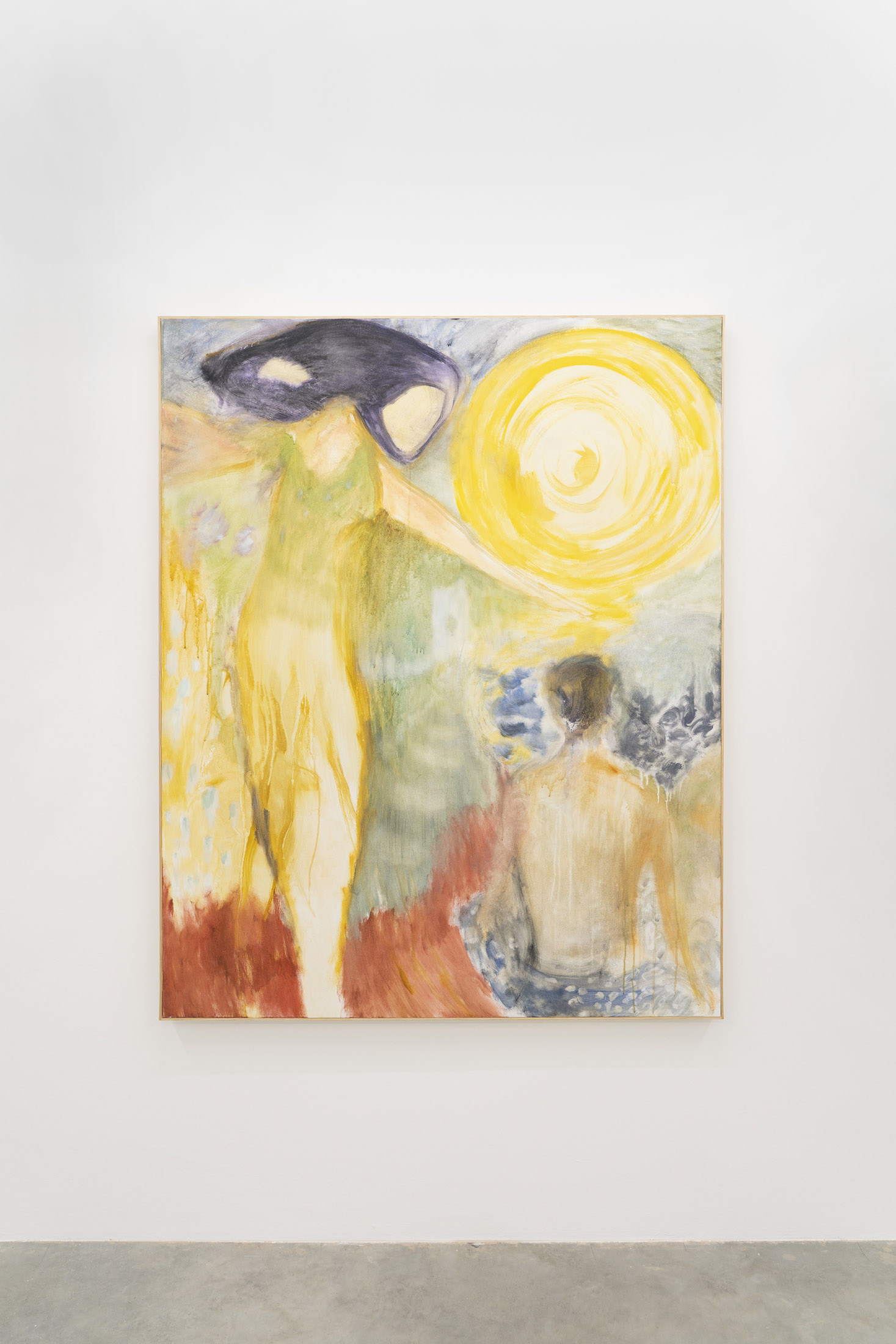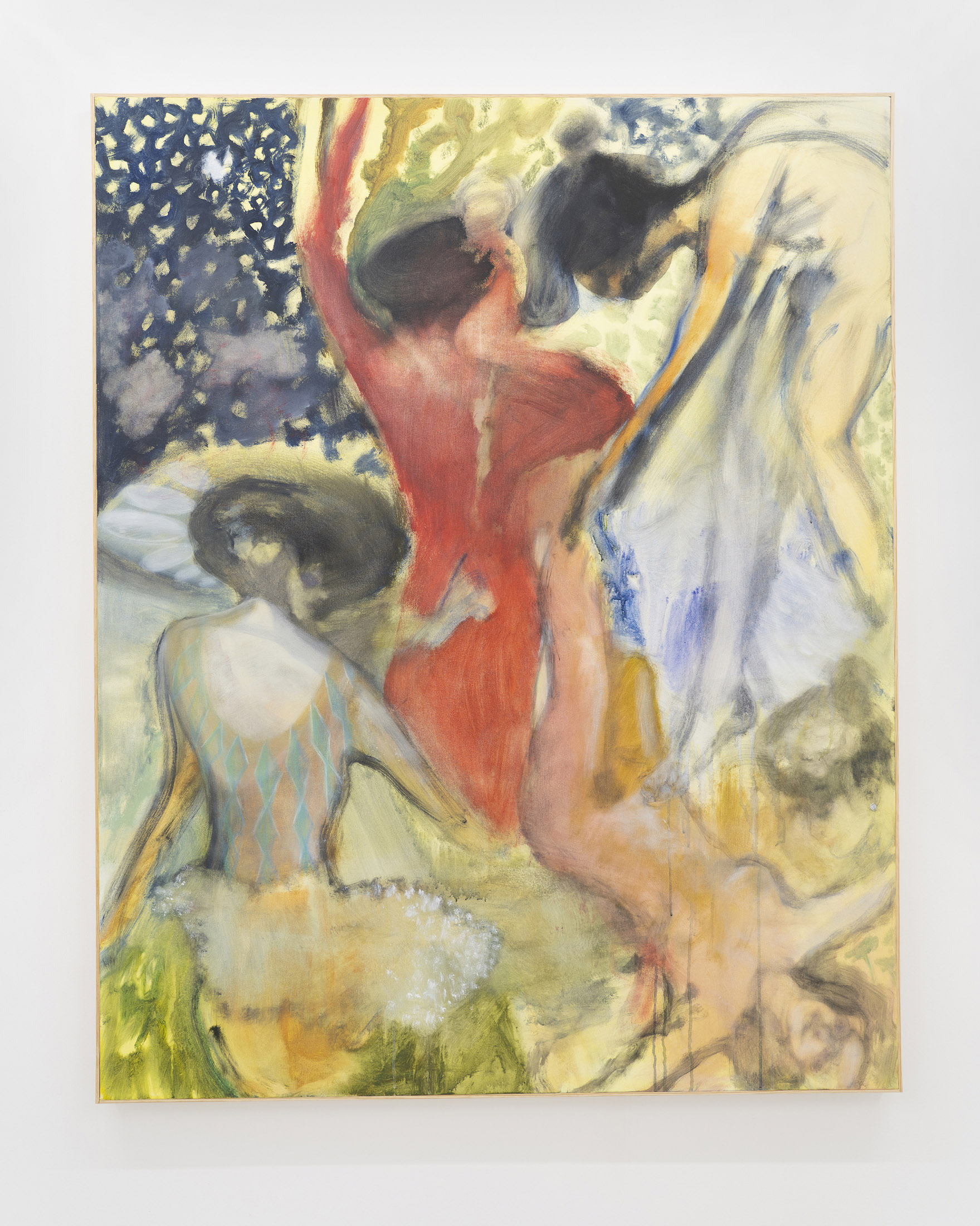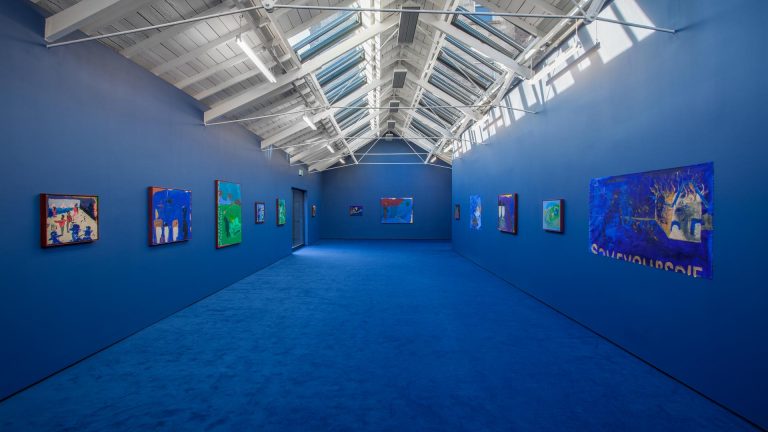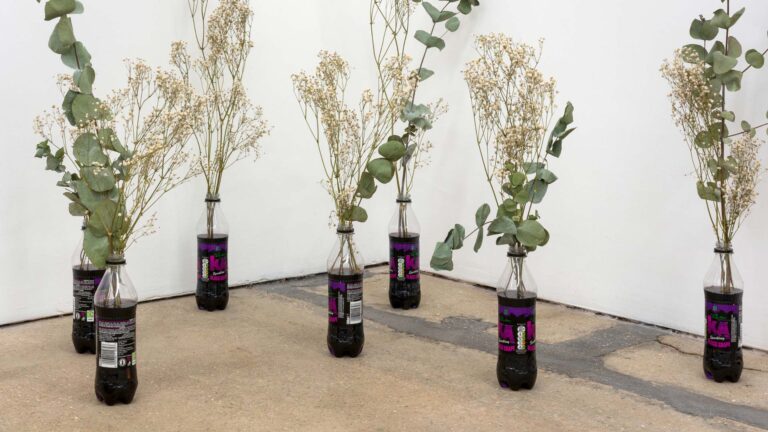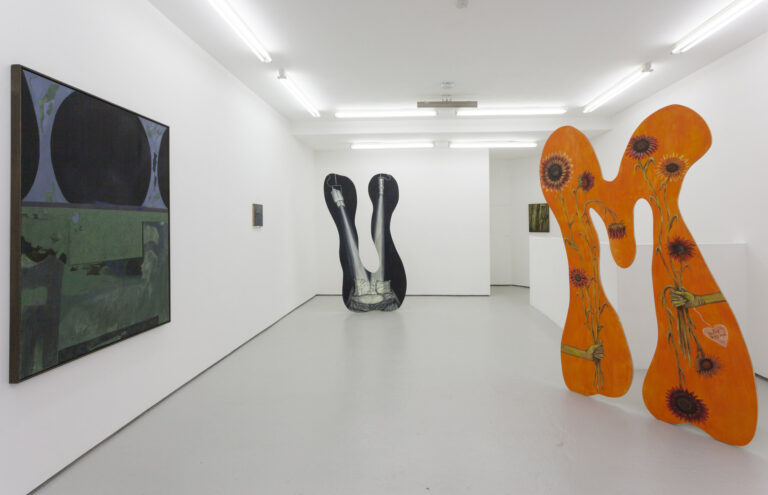Artist: Ted Gahl
Exhibition title: Café Nervosa
Venue: MAMOTH, London, UK
Date: September 28 – November 3, 2023
Photography: all images copyright and courtesy of the artist and MAMOTH, London
MAMOTH is pleased to announce “Café Nervosa”, Ted Gahl’s second solo exhibition with the gallery, on view from 28 September to 3 November 2023. “Café Nervosa” presents a selection of new works by Ted Gahl, exploring personal experiences of entrapment, anxiety, joy and longing. Ruminating on these themes since the onset of the Covid-19 Pandemic, Gahl’s new body of work summons nostalgia for the uninhibited café society of the Parisian Belle Epoque, tempered with the encroaching anxieties of the 21st Century and TV sitcom escapism.
Anxious Times: Tom Morton on Ted Gahl
Ted Gahl is a painter of moods. Often populated by ethereal figures, who occupy shimmering, ambiguous spaces that appear always on the cusp of dissolving into constellations of abstract pigment, his canvases resemble scenes from fugitive memories, hazily recalled works of fiction or rapidly evanescing dreams. What’s foregrounded here isn’t narrative, or at least not in any straightforward sense, but rather the subtle calibration of atmosphere. This is a difficult quality to point to, located as it is in the interplay of every painterly element and decision – colours, forms, textures, composition – that Gahl brings to a given work. And yet, we should not mistake atmosphere for something insubstantial. In the passing of time, human beings forget the vast majority of their lived experience, and even the most significant events in our personal histories rarely survive within us intact and entire. What linger in our minds, though, what always abide, are feeling tones – particular, suffusing moods.
Gahl’s exhibition Café Nervosa takes its title from a coffee house in the American sitcom Frasier (1993–2004), where the show’s titular neurotic psychiatrist Frasier Crane meets up with his equally highly strung brother Niles, to work through – or more usually wallow in – their many issues, both real and wholly imagined. To them at least, this establishment is a descendant of the celebrated European cafés where Modernity’s intellectual and artistic greats once gathered – think Landtmann in Vienna (frequented by Sigmund Freud, Thomas Mann and Gustav Mahler), or Les Deux Magots in Paris (whose patrons included Pablo Picasso, James Baldwin and Simone de Beauvoir). Frasier, though, is set in 1990s Seattle, and the snobbish, pretentious and ultimately conservative Cranes are nobody’s idea of a pre-millennial avant-garde. Perhaps what Gahl is signalling with his show’s title is that nostalgia, for all its inexorable romantic pull, can summon up nothing more than a lifeless facsimile of a disappeared world. The only vital energy that the sitcom’s coffee house really supplies is, as its name suggests, caffeine-fuelled jitters. We might note here that in 2023, almost two decades after Frasier’s final episode first aired, anxiety feels like a very contemporary state of mind.
In Gahl’s painting Café Nervosa (2) (all works 2023), we see round tables set out on a terrace by a navy sea, under a cloudy grey-gold sky. Is this a place of dazzling cultural ferment? There’s certainly something glamourously bohemian about the central figure, whose long, loose dress seems to wink with hundreds of tiny points of reflected light, like the myriad glassy surfaces in Édouard Manet’s painting A Bar at the Folies-Bergère (1882). Strikingly, the figure to the left of the canvas has a pale, eyeless skull where we might expect a face. Death stalks this beachside café, but instills no fear in the other patrons, who appear unable to see this macabre spectre, or else stubbornly refuse to acknowledge its presence. Another, much slimmer possibility is that they’ve made an accommodation with their own mortality, have accepted it as their daily companion. If so, theirs is a rare wisdom indeed.
Cleaving very close to abstraction, City by the Sea suggests a coastal metropolis, conjured in raw, rust-toned paints on unprimed canvas. We might read it as the location where the action in Gahl’s other paintings takes place. See You in the City pulses with the giddy energy of urban living. Beneath what might be a looming sun, a figure wearing something akin to Venetian carnival costume points out towards us, drawing us into an effervescing, psychedelically blurred world of colour and light. Another solar form blazes in Owenego (Tower). Here, a woman appears to guide a young man waist-deep into the ocean. Are the pair simply spending a day’s leisure at the beach, or are they performing a kind of baptismal ritual? The youth faces away from us, towards the sun, which yellows the endless dark waters. We have no idea how far out he’ll swim, or when – if ever – he’ll return to dry land.
Tragedy Coat is perhaps the most personal of these paintings, drawing as it does on the loss many years ago of a close family friend, who drowned after she fell from a bluff. The motif of a falling woman has appeared before in Gahl’s works, and here it graces a shawl worn by an ambiguously gendered, determinedly cruciform figure, who seems to hover between what might be two towering Modernist buildings, and stare out into the black, star-flecked night beyond. There is a tension in this image between not only ascent and descent, but between containment (the nude falling woman, bounded by the busily patterned, kite-shaped shawl) and expansion (the clothed hovering figure, who might at any moment soar up into boundless space). Does Tragedy Coat depict a resurrection, or even an apotheosis? What is remarkable is how still this painting feels, how peaceful, as though time itself had been suspended, and a pause placed on gravity’s ceaseless pull.
Contrast this atmosphere of calm with the lively bodies that sweep across the canvas in Performers, a work that recalls both Edgar Degas’s paintings of ballerinas, and the aqueous colour-based abstraction of Helen Frankenthaler. What structures this canvas is the weaving of positive and negative space, and this is replicated in miniature in the diamond pattern (a nod to those great painters of the harlequin, Jean-Antoine Watteau, Paul Cézanne and Pablo Picasso?) that adorns the tutu of the dancer on the composition’s lower left. Notably, we do not see Gahl’s Performers engaged in a performance. Rather, he depicts them in what appears, from their various states of dress and undress, to be a backstage space. This is, then, an image about anticipation –about the anxious, invigorating energy that precedes (and powers) a step into the spotlight, where the dancers will give themselves over to pure motion, pure flow.
Gahl’s paintings are much preoccupied with the experience of time – its cruelties and comforts, its sudden shifts in speed, its lacunae and its loops – and this is nowhere more in evidence than in I Hope To See You Again. The work takes its title from a note sent to the artist by the family friend memorialised in Tragedy Coat on the death of his grandfather, a document that now, of course, registers a double loss. Against a black ground, we see two women embrace, their heads echoed by a pair of flanking lamps or moons, while above them fiery lights (are they a meteor shower, a distant forest fire, a volcanic eruption?) scorch the night sky. Gahl has described this painting as ‘a fictional reunion’, in which the figures ‘see someone they love again’, despite ‘the permanence of death’. While we cannot discount the work’s apocalyptic undertow, and its sombre, elegiac mood, it is – as its title suggests – perhaps ultimately an optimistic vision. As the artist understands, we live in moments, we remember in moments, and we hope in moments, too.
-Text by Tom Morton
Ted Gahl (b. 1983) lives and works in New Haven, Connecticut. Gahl obtained his BFA from Pratt Institute in 2006 and MFA from Rhode Island School of Design in 2010. In 2022, he was a recipient of a Pollock-Krasner Foundation Grant. Recent solo exhibitions include: “Le Goon”, Harkawik, New York (2023); “She is my Clock”, MAMOTH, London, UK, (2022); “Stories from the City, Stories from the Sea”, Harkawik, Los Angeles, California, USA (2021); “March Pictures”, Halsey McKay, East Hampton, New York, USA, (2021); “Metro-North”, Massif Central, Brussels, BE, (2021); “Paintings”, Alexander Berggruen, New York, USA, (2020); “Suet Paintings/Smoker by Window”, Y2K group, New York, USA, (2020); “Zen Paintings”, Vicki, Newburgh, New York, USA, (2019); “Lamu”, Halsey McKay, East Hampton, New York, USA, (2019); “Towers:, Romer Young Gallery, San Francisco, CA, (2017); “Mind Reels”, Halsey McKay Gallery, New York, NY, (2017); “Beaumont Sur Mer”, Halsey McKay Gallery, East Hampton, NY, (2017); “Lights”, Towards Gallery, Toronto, ON, Canada (2017).
Recent group exhibitions include: “(Mostly) Women (Mostly) Abstract”, Eric Firestone, New York, NY, (2023); “2023 White Columns Benefit”, New York, NY, (2023); “The Shape of Time”, Alice Amati, London, (2023); “Body Full of Stars”, Ceysson & Bénétière, New York, NY, (2023); “Moon Juice”, Waldburger Wouters, Brussels, (2023); “Threshold”, 91 Allen, New York, (2023); “Ted Gahl/ Betty Kingseed”, Towards, Toronto, Canada, (2022); “The Glass Bead Game”, MAMOTH, London, UK, (2021); “Peinture en trois services”, Valentin, Paris, FRA, (2021); “dal segno”, Y2K group, New York, New York, USA, (2021); “Kindred Spirits”, Bjorn & Gundorph, Aarhus, DK, (2020); Drawing in Lockdown, S.M.A.K., Ghent, BE, (2020); “Summer Stock”, Craven Contemporary, Kent, CT, (2020); “Do You Like Worms?”, Gazebo, Newark, DE, (2020); “Woof of the Sun, Ethereal Gauze”, Halsey McKay, East Hampton, New York, USA, (2020); “Nostos”, Matthew Brown Gallery, Los Angeles, (2019); “Freddy’s World”, Fisher Parrish Gallery, Brooklyn, NY, (2019); “Wildernesses”, Peninsula Art Space, Brooklyn, NY, (2019); “ A Tinkling Sound”, curated by Bradford Kessler, Kunsthalle Wichita, Wichita, KS, (2019); “The Burn Show”, Safe Gallery at Folly Tree Arboretum, East Hampton, NY, (2019); “Ramblin’ Round”, Stonehouse Art Projects, Cortland, NY, (2019); “Highlight/The Highline”, organised.
Ted Gahl, Café Nervosa, 2023, exhibition view, MAMOTH, London
Ted Gahl, Café Nervosa, 2023, exhibition view, MAMOTH, London
Ted Gahl, Café Nervosa, 2023, exhibition view, MAMOTH, London
Ted Gahl, Café Nervosa, 2023, exhibition view, MAMOTH, London
Ted Gahl, Café Nervosa, 2023, exhibition view, MAMOTH, London
Ted Gahl, Café Nervosa, 2023, exhibition view, MAMOTH, London
Ted Gahl, Café Nervosa, 2023, exhibition view, MAMOTH, London
Ted Gahl, I Hope To See You Again, 2023, Acrylic, Moroccan pigments, graphite, coloured pencil on canvas in artist’s frame, 60 x 48 in / 152.4 x 121.9 cm
Ted Gahl, Jane with Stars, 2023, Acrylic, graphite, and coloured pencil on canvas, 10 x 20 in / 25.4 x 50.8 cm
Ted Gahl, Owenego (Tower), 2023, Acrylic, Moroccan pigments, graphite, coloured pencil on canvas in artist’s frame, 60 x 48 in / 152.4 x 121.92 cm
Ted Gahl, Performers, 2023, Acrylic, Moroccan pigments, graphite, coloured pencil on canvas in artist’s frame, 60 x 48 in / 152.4 x 121.92 cm
Ted Gahl, Tragedy Coat, 2023, Acrylic, Moroccan pigments, graphite, coloured pencil on canvas in artist’s frame, 60 x 48 in, 152.4 x 121.92 cm


